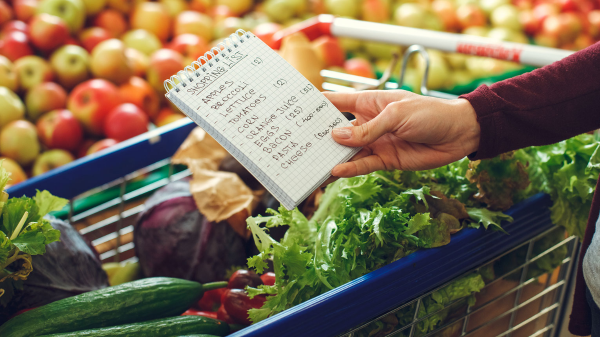
Horse breeder Muriel Bing makes it sound exotic: “It is normal to enjoy strolling through the isles of the supermarket.”
Her comment is in response to a recent Internet article reminding us that “grocery shopping doesn’t have to suck” and she probably meant “aisles.”
The article offers several tips: “Do it from your couch.” Certainly: if you hate going to the supermarket, just admit it and make the transition online.
Another: “Go to cool stores/markets to make grocery shopping, daresay, fun.”
Some perspective is needed. The writer, Caroline Chambers, is based in Carmel Valley, CA, which has a median household income of $218,484 a year.
Nearby Carmel-by-the-Sea (former mayor: Clint Eastwood) has a median household income of $190,365.
Consequently, Ms. Chambers’ perspective—”I love popping into this cool market (Elroy’s!) in Monterey for fresh pasta, and I love taking the beasts to the Carmel Valley Farmer’s Market on Sundays to buy seasonal produce that I then build our meals around”—no doubt reflects a cornucopia of delightful high-end markets nearby.
Her advice may not apply in all areas. My wife’s family has a summer house in the far north of Wisconsin. The one grocery store within 25 miles doesn’t afford the same degree of shopping pleasure.
Ms. Chambers offers one tip that is relevant to the produce industry: “Maybe you should stop bulk buying? It took me a lot of spoiled produce to realize that at this phase in my life, my family is just not good candidates for a Costco membership. So much spinach was sacrificed while learning this lesson, RIP.”
Bulk buying is great for toilet paper and toothpaste (assuming you have the storage space). It’s not always great for fresh produce.
Perhaps counterintuitively, the industry might launch a campaign offering tips on how much fresh fruit and vegetables to buy, how often—and how not to buy.
It is my considered opinion that if you have just thrown out a soggy, greenish vegetative mass that was once fresh spinach, you are less likely to buy fresh spinach on your next jaunt to the grocer.
Some helpful tips on how much produce to buy at any given time might lead to less wastage of fresh fruits and vegetables as well as to improved sales in the long run if they increase their shopping trips.
Everybody wants to avoid wasting food. Maybe people just need a little more advice on how.
Horse breeder Muriel Bing makes it sound exotic: “It is normal to enjoy strolling through the isles of the supermarket.”
Her comment is in response to a recent Internet article reminding us that “grocery shopping doesn’t have to suck” and she probably meant “aisles.”
The article offers several tips: “Do it from your couch.” Certainly: if you hate going to the supermarket, just admit it and make the transition online.
Another: “Go to cool stores/markets to make grocery shopping, daresay, fun.”
Some perspective is needed. The writer, Caroline Chambers, is based in Carmel Valley, CA, which has a median household income of $218,484 a year.
Nearby Carmel-by-the-Sea (former mayor: Clint Eastwood) has a median household income of $190,365.
Consequently, Ms. Chambers’ perspective—”I love popping into this cool market (Elroy’s!) in Monterey for fresh pasta, and I love taking the beasts to the Carmel Valley Farmer’s Market on Sundays to buy seasonal produce that I then build our meals around”—no doubt reflects a cornucopia of delightful high-end markets nearby.
Her advice may not apply in all areas. My wife’s family has a summer house in the far north of Wisconsin. The one grocery store within 25 miles doesn’t afford the same degree of shopping pleasure.
Ms. Chambers offers one tip that is relevant to the produce industry: “Maybe you should stop bulk buying? It took me a lot of spoiled produce to realize that at this phase in my life, my family is just not good candidates for a Costco membership. So much spinach was sacrificed while learning this lesson, RIP.”
Bulk buying is great for toilet paper and toothpaste (assuming you have the storage space). It’s not always great for fresh produce.
Perhaps counterintuitively, the industry might launch a campaign offering tips on how much fresh fruit and vegetables to buy, how often—and how not to buy.
It is my considered opinion that if you have just thrown out a soggy, greenish vegetative mass that was once fresh spinach, you are less likely to buy fresh spinach on your next jaunt to the grocer.
Some helpful tips on how much produce to buy at any given time might lead to less wastage of fresh fruits and vegetables as well as to improved sales in the long run if they increase their shopping trips.
Everybody wants to avoid wasting food. Maybe people just need a little more advice on how.
Richard Smoley, contributing editor for Blue Book Services, Inc., has more than 40 years of experience in magazine writing and editing, and is the former managing editor of California Farmer magazine. A graduate of Harvard and Oxford universities, he has published 12 books.




